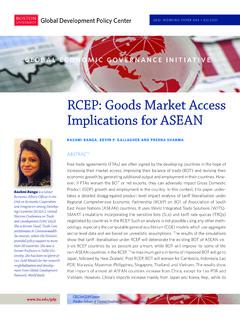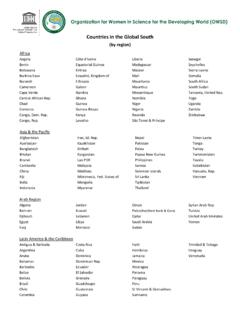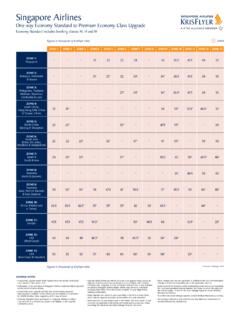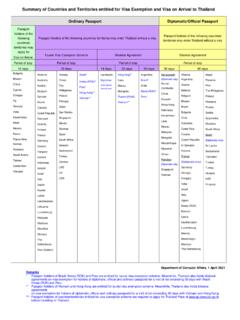Transcription of The Global Disinformation Order - University of Oxford
1 The Global Disinformation Order 2019 Global Inventory of Organised Social Media ManipulationSamantha Bradshaw . University of OxfordPhilip N. Howard . University of Oxford2019 Global INVENTORY OF ORGANISED SOCIAL MEDIA MANIPULATION [ i ]Executive SummaryComputational propaganda the use of algorithms, automation, and big data to shape public life is becoming a pervasive and ubiquitous part of everyday life. Over the past three years, we have monitored the Global organization of social media manipulation by governments and political parties. Our 2019 report analyses the trends of computational propaganda and the evolving tools, capacities, strategies, and resources. 1. Evidence of organized social media manipulation campaigns which have taken place in 70 countries, up from 48 countries in 2018 and 28 countries in 2017. In each country, there is at least one political party or government agency using social media to shape public attitudes domestically (Figure 1).
2 2. Social media has become co-opted by many authoritarian regimes. In 26 countries, computational propaganda is being used as a tool of information control in three distinct ways: to suppress fundamental human rights, discredit political opponents, and drown out dissenting opinions (Figure 2). 3. A handful of sophisticated state actors use computational propaganda for foreign influence operations. Facebook and Twitter attributed foreign influence operations to seven countries (China, India, Iran, Pakistan, Russia, Saudi Arabia, and Venezuela) who have used these platforms to influence Global audiences (Figure 3).4. China has become a major player in the Global Disinformation Order . Until the 2019 protests in Hong Kong, most evidence of Chinese computational propaganda occurred on domestic platforms such as Weibo, WeChat, and QQ.
3 But China s new-found interest in aggressively using Facebook, Twitter, and YouTube should raise concerns for democracies5. Despite there being more social networking platforms than ever, Facebook remains the platform of choice for social media manipulation. In 56 countries, we found evidence of formally organized computational propaganda campaigns on Facebook. (Figure 4).2019 Global INVENTORY OF ORGANISED SOCIAL MEDIA MANIPULATION [ ii ]IntroductionReport MethodologyOrganisational FormStrategies, Tools, and TechniquesOrganisational Budgets, Behaviours, and Capacity ConclusionReferencesAcknowledgementsAuth ors Biographies179111721222323 ContentsILLUSTRATIONSF igure 1 - The Global Disinformation OrderFigure 2 - Computational Propaganda as a Tool of Information Control Figure 3 - Foreign Influence Operations on Social MediaFigure 4 - Prominent Platforms for Social Media Manipulation Table 1 - Organizational Form and Prevalence of Social Media ManipulationTable 2 - Fake Account Types Table 3 - Messaging and ValenceTable 4 - Communication Strategies Table 5 - Cyber Troop Capacity3556 1012 1416 18 This report can be cited as: Samantha Bradshaw & Philip N.
4 Howard. (2019) The Global Disinformation Disorder: 2019 Global Inventory of Organised Social Media Manipulation. Working Paper Oxford , UK: Project on Computational Global INVENTORY OF ORGANISED SOCIAL MEDIA MANIPULATION [ 1 ]Although propaganda has always been a part of political discourse, the deep and wide-ranging scope of these campaigns raise critical public interest concerns. Cyber troops are defined as government or political party actors tasked with manipulating public opinion online (Bradshaw and Howard 2017a). We comparatively examine the formal organization of cyber troops around the world, and how these actors use computational propaganda for political purposes. This involves building an inventory of the evolving strategies, tools, and techniques of computational propaganda, including the use of political bots to amplify hate speech or other forms of manipulated content, the illegal harvesting of data or micro-targeting, or deploying an army of trolls to bully or harass political dissidents or journalists online.
5 We also track the capacity and resources invested into developing these techniques to build a picture of cyber troop capabilities around the world. The use of computational propaganda to shape public attitudes via social media has become mainstream, extending far beyond the actions of a few bad actors. In an information environment characterized by high volumes of information and limited levels of user attention and trust, the tools and techniques of computational propaganda are becoming a common and arguably essential part of digital campaigning and public diplomacy. In addition to building a globally comparative picture of cyber troop activity, we also hope to drive public and scholarly debate about how we define and understand the changing nature of politics online, and how technologies can and should be used to enhance democracy and the expression of human rights online.
6 In this year s report, we examine cyber troop activity in 70 countries: Angola, Argentina, Armenia, Australia, Austria, Azerbaijan, Bahrain, Bosnia & Herzegovina, Brazil, cambodia , China, Colombia, Croatia, Cuba, Czech Republic, Ecuador, Egypt, Eritrea, Ethiopia, Georgia, Germany, Greece, Honduras, Guatemala, Hungary, India, Indonesia, Iran, Israel, Italy, Kazakhstan, Kenya, Kyrgyzstan, Macedonia, Malaysia, Malta, Mexico, Moldova, Myanmar, Netherlands, Nigeria, North Korea, Pakistan, Philippines, Poland, Qatar, Russia, Rwanda, Saudi Arabia, Serbia, South Africa, South Korea, Spain, Sri Lanka, Around the world, government actors are using social media to manufacture consensus, automate suppression, and undermine trust in the liberal international Global INVENTORY OF ORGANISED SOCIAL MEDIA MANIPULATION [ 2 ]have begun publishing limited information about influence operations on their platforms have taken action against cyber troops engaged in foreign influence operations in seven countries: China, India, Iran, Pakistan, Russia, Saudi Arabia, and Venezuela.
7 Although this measure does not capture the extent to which foreign influence operations are taking place, we can confidently begin to build a picture of this highly secretive phenomenon. China Flexes its Misinformation Muscle Until recently, we found that China rarely used social media to manipulate public opinion in other countries. The audience for computational propaganda has mainly focused on domestic platforms, such as Weibo, WeChat, and QQ. However, in 2019 the Chinese government began to employ Global social media platforms to paint Hong Kong s democracy advocates as violent radicals with no popular appeal (Lee Myers and Mozur 2019). Beyond domestically bound platforms, the growing sophistication and use of Global social networking technologies demonstrates how China is also turning to these technologies as a tool of geopolitical power and is Still Number One Despite there being more platforms than ever, Facebook remains the dominant platform for cyber troop activity.
8 Part of the reason for this could be explained by its market size as one of the world s largest social networking platforms as well as the specific affordances of the platform, such as close family and friend communication, a source of political news and information, or the ability to form groups and pages. Since 2018, we have collected evidence of more cyber troop activity on image- and video-sharing platforms such as Instagram and YouTube. We have also collected evidence of cyber troops running campaigns on WhatsApp. We think these platforms will grow in importance over the next few years as more people use these social networking technologies for political , Syria, Taiwan, Tajikistan, thailand , Tunisia, Turkey, Ukraine, United Arab Emirates, United Kingdom, United States, Uzbekistan, Venezuela, vietnam , and Evidence of Computational Propaganda Around the WorldWe found evidence of organised social media manipulation campaigns in 70 countries, up from 48 countries in 2018 and 28 countries in 2017.
9 Some of this growth comes from new entrants who are experimenting with the tools and techniques of computational propaganda during elections or as a new tool of information control. However, journalists, academics, and activists are also better equipped with digital tools and a more precise vocabulary to identify, report, and uncover instances of formally organized social media manipulation. Over the past three years we have been able to refine our language and search terms for identifying instances of computational propaganda, and we found that many countries have displayed elements of formally organized social media manipulation for the past decade. As a result, we suggest that computational propaganda has become a ubiquitous and pervasive part of the digital information ecosystem. The Co-Option of Social Media in Authoritarian RegimesIn many authoritarian regimes, computational propaganda has become a tool of information control that is strategically used in combination with surveillance, censorship, and threats of violence.
10 We have catalogued the kinds of campaigns authoritarian countries have used against journalists, political dissidents, and the broader society, and found three distinct ways in which computational propaganda is used: (1) to suppress fundamental human rights; (2) to discredit political opposition; and (3) to drown out political dissent. The co-option of social media technologies provides authoritarian regimes with a powerful tool to shape public discussions and spread propaganda online, while simultaneously surveilling, censoring, and restricting digital public spaces. A Limited Number of Foreign Influence Operations by Highly Sophisticated ActorsForeign influence operations are an important area of concern but attributing computational propaganda to foreign state actors remains a challenge. Facebook and Twitter who 150%the increase in countries using organised social media manipulation campaigns over the last two years2017 Number of Countries201820192848702019 Global INVENTORY OF ORGANISED SOCIAL MEDIA MANIPULATION 2019 Global INVENTORY OF ORGANISED SOCIAL MEDIA MANIPULATION [ 4 ][ 3 ]






